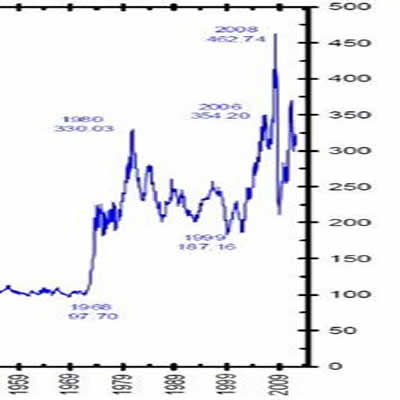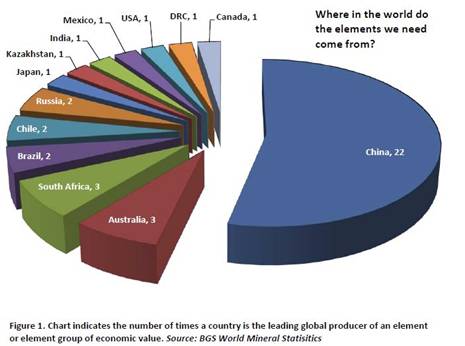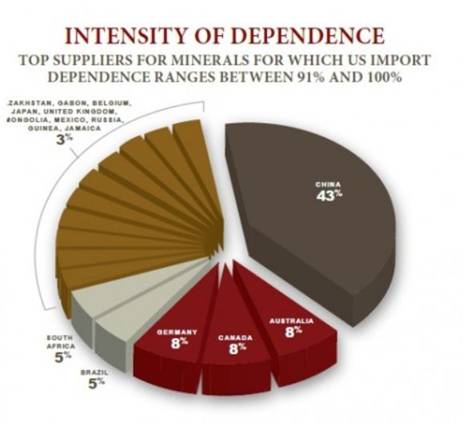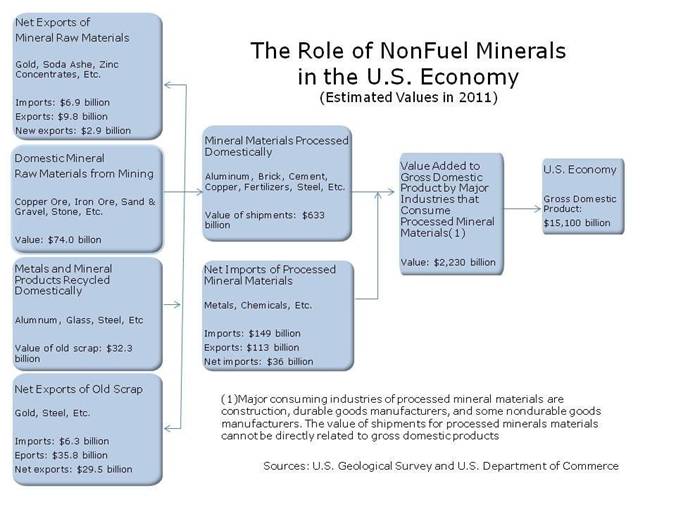American Glory Days, Made in America Again Needs Resource Extraction and Agriculture
Commodities / Resources Investing Dec 29, 2012 - 04:49 AM GMTBy: Richard_Mills
 Gus Gunn, of the British Geological Survey, has identified three main factors behind the steep rise in commodity demand and prices:
Gus Gunn, of the British Geological Survey, has identified three main factors behind the steep rise in commodity demand and prices:
• Urbanization that is accompanied by a rise in the standard of living. By 2025, nearly 2.5 billion Asians will live in cities, accounting for almost 54 percent of the world's urban population. India and China alone will account for more than 62 percent of Asian urban population growth and 40 percent of global urban population growth from 2005 to 2025
• Population increase, since 1950, the world's population has gone from 2.5 billion people to seven billion. No less than 75 million people a year are added to this number, the world's population is expected to exceed nine billion by 2050 and reach 10.1 billion by the end of the century - according to the United Nations

• Development of new technologies whose components and gadgets are based on an ever broader base of elements. Your television contains 35 different minerals, your computer 30, your cell phone contains 42, more silver is used in electronics manufacturing than in making jewelry
Minerals unique properties contribute to supplying us with food, shelter, infrastructure, transportation, communications, health care, manufacturing, new technologies and defense.
Import reliance of minerals is of particular relevance to the United States and serious concerns have been raised, since at least the early 1980's, that the necessary critical and strategic mineral resources will not be available to meet soaring demand for current and emerging products and technologies.


"Our enormously productive economy... demands that we make consumption our way of life, that we convert the buying and use of goods into rituals, that we seek our spiritual satisfaction, our ego satisfaction, in consumption... We need things consumed, burned up, worn out, replaced, and discarded at an ever increasing rate." ~ Victor Lebow, 1955
America depends upon overseas suppliers for over 80 percent of its most important critical minerals.
"The United States is the world's third largest Copper producer, yet a 2010 MIT study by Elisa Alonso notes that the risk of Copper disruption is significantly greater than for other major metals, and is at or near an historical high. The Office of the Secretary of Defense lists Copper as a metal that has, "[Already] caused some kind of weapon production delay for the DoD." *Copper is also the primary metal for other strategic and critical metals highlighted in this report. Significant amounts of Molybdenum, Rhenium (nearly 75% of world's production), Tellurium and Selenium (95% of world's production) come from Copper mining and refining. Copper shortages will trigger companion shortages in these metals as well. We highlight this to further demonstrate the shortsightedness of targeting metals based entirely on stand-alone percentages." ~ The American Resources Policy Network report, "Assessing Risk: Critical Metals and National Security
*Researchers have concluded that the U.N.'s estimated global population of ten billion people (by the end of this century) could consume 1.7 trillion kilograms of copper, total global in-ground stocks of copper are estimated at 1.6 trillion kilograms.
The American Resources Policy Network report notes that **China supplies more than one in five of the minerals that are vital to the America's commercial and defense sectors despite the fact that proven U.S. resources exist for 40 of the 46 minerals reviewed, or 87 percent of these minerals.
**China is the leading producer of the following commodities:
Cement 50%, coal 40%, iron ore 39%, phosphate rock 35%, gypsum 28%, zinc 25%, barite 55%, lead 43%, manganese 25%, rare earths 97%, molybdenum 39%, tungsten 81%, arsenic 47%, vanadium 37%, cadmium 23%, gold 13%, mercury 63%, indium 50%, germanium
The 1981 report "A Congressional Handbook on U.S. Minerals Dependency/Vulnerability" singled out eight materials "for which the industrial health and defense of the United States is most vulnerable to potential supply disruptions" ~ the first five have been called 'the metallurgical Achilles heel of our civilization.'
In 1984 U.S. Marine Corps Major R.A. Hagerman wrote: "Since World War ll, the United States has become increasingly dependent on foreign sources for almost all non-fuel minerals. The availability of these minerals have an extremely important impact on American industry and, in turn, on U.S. defense capabilities. Without just a few critical minerals, such as cobalt, manganese, chromium and platinum, it would be virtually impossible to produce many defense products such as jet engine, missile components, electronic components, iron, steel, etc. This places the U.S. in a vulnerable position with a direct threat to our defense production capability if the supply of strategic minerals is disrupted by foreign powers."
In 2011 Daniel McGroarty, President of the American Resources Policy Network had this to say:
"The U.S. government desperately needs a coherent national mineral access strategy. We are acutely dependent on foreign supplies of non-fuel minerals and metals that are vital to commercial manufacturing and advanced weapons systems. Our exposure to potential supply disruptions is a profound national security threat."
According to the U.S. Geological Survey (USGS) the value of raw, nonfuel minerals mined in the United States was $74 billion in 2011, up from $66 billion in 2010, domestic raw materials and domestically recycled materials were used to process and produce mineral materials worth $633 billion. Final products, such as cars and houses, produced by major U.S. industries using mineral materials made up about 15 percent (more than $2.2 trillion) of the 2011 gross domestic product.
"Without increased domestic exploration, significant declines in U.S. mineral production are unavoidable as present reserves are exhausted. We will continue to ship American jobs overseas and forfeit our economic competitiveness unless we take steps to develop our own mineral resources." ~ Subcommittee on Energy and Mineral Resources Chairman Doug Lamborn

It's obvious minerals are part of virtually every product we use and that mineral production is a key economic activity that creates jobs and improves any countries national security.
Yet...
In 1978 the United States was 100 percent import dependent for seven mineral commodities, and more than 50 percent import dependent for 25 mineral commodities.
In 2011, the United States was 100 percent reliant on imports for 19 mineral commodities and relied on foreign sources to supply more than 50 percent of 43 mineral commodities.
2011 U.S. Net Import Reliance for Selected Non-fuel Minerals
The irony is that the U.S. contains 15 percent of available global resources yet barely contributes one percent of global supply.
Perhaps that's because America is one of the toughest places in the world to bring a new mine online. It takes up to ten years, on average, to obtain all the necessary permits.
In May 2011, the U.S. House Subcommittee on Energy and Mineral Resources held a hearing titled "Strategic and Critical Minerals Policy: Domestic Minerals Supplies and Demands in a time of Foreign Supply Disruptions."
Here's a bit of whatHal Quinn, CEO of the National Mining Association said in his testimony;
"America's drift away from greater self-sufficiency for the basic building blocks of our economy compromises our economic and national security and ignores this country's rich reserves of metals and minerals. It is time for policymakers to meet head-on the larger issue of how our country can produce more domestic minerals to meet a greater share of our needs...the U.S. has one of the world's greater mineral repositories, our ability to get these minerals into the supply chain to help meet more of America's needs is threatened. Numerous public policies have placed high hurdles in our lane of the global race to remain competitive. If commodity cycles are historically 20 years in duration, the 10 years it takes to obtain permits leaves U.S. mining still in the starting blocks with the race half way over."
The high hurdles Quinn is referring to are :
- Restrictions on federal land access, approximately three-fourths of the 750 million acres of public land has been closed to exploitation, and closure continues
- The U.S. has world's highest statutory taxation rate
- Regulatory hurdles, restrictive environmental regulations make mining and processing more difficult and costly and has increased lead times for new mine development - the nonfuel minerals industry is impeded by 80 different laws administered by 20 different agencies
It should not come as a surprise to anyone that the U.S. share of investment in mining is at an all-time low dropping from 21 percent of the world's mining investment in the early 1990's to ten percent in 2000 and eight percent today.
There are only two remedies available that would effectively reduce the U.S.'s dependence on mineral imports: open up presently off limit federal land and secondly, the mine permitting process needs to be streamlined by Congress so that it can meet the nation's advanced manufacturing and defense needs.
"When it comes to strategic metals and minerals, we need government agencies like the EPA to proactively work with industry to effectively develop America's natural resources, rather than expand its regulatory authority in an effort to shut projects down." Lisa Reisman, Executive Editor of Metal Miner."
Now i think i'm going down to the well tonight And i'm going to drink till i get my fill And i hope when i get old i don't sit around thinking about it But i probably will Yeah, just sitting back trying to recapture A little of the glory of, well time slips away And leaves you with nothing mister but Boring stories of glory days Glory Days, Bruce Springsteen
Conclusion
"Maintaining the American standard of living required 7.1 billion tons of rocks and minerals last year to make the things we use and depend upon every day. Every year, nearly 48,000 pounds of new minerals must be provided for every person in the United States to make the products we buy and the various things we use and with 300 million people in the U.S. expecting to live comfortably and affordably, mining has to occur somewhere." ~ Nelson Fugate, president of the Denver-based Mineral Information Institute (MII).
"NOT MADE IN AMERICA" stickers are now found on nearly every item for sale in America. In 1985, the US imported less than $4 billion worth of goods from China, and the country had just a small trade deficit. Today, the US spends almost $400 billion per year just on Chinese goods and has a massive trade deficit with the world.
Real new wealth, and an economic superpower, are only created when a countries resources are used to manufacture goods to sell at home and abroad - when a countries natural resources are used to provide solid long term high paying jobs. When people are working, and have discretionary income, economic stimulus results. The United States of America was an economic superpower for these very reasons. The US needs to regenerate and re-grow its economy - restart the process of generating new wealth - this creates jobs and brings national prosperity.
Resource extraction and agriculture are the primary sources of wealth.
Exploitation of the United States own natural resources, combined with a solid manufacturing sector could be the economic drivers of a resurgent US economy. 'Made Again In America' and a return to 'Glory Days' should be on everyone's radar screen. Are they on yours?
If not, maybe they should be.
By Richard (Rick) Mills
If you're interested in learning more about the junior resource and bio-med sectors please come and visit us at www.aheadoftheherd.com
Site membership is free. No credit card or personal information is asked for.
Richard is host of Aheadoftheherd.com and invests in the junior resource sector.
His articles have been published on over 400 websites, including:
Wall Street Journal, Market Oracle, SafeHaven , USAToday, National Post, Stockhouse, Lewrockwell, Pinnacledigest, Uranium Miner, Beforeitsnews, SeekingAlpha, MontrealGazette, Casey Research, 24hgold, Vancouver Sun, CBSnews, SilverBearCafe, Infomine, Huffington Post, Mineweb, 321Gold, Kitco, Gold-Eagle, The Gold/Energy Reports, Calgary Herald, Resource Investor, Mining.com, Forbes, FNArena, Uraniumseek, Financial Sense, Goldseek, Dallasnews, Vantagewire, Resourceclips and the Association of Mining Analysts.
Copyright © 2012 Richard (Rick) Mills - All Rights Reserved
Legal Notice / Disclaimer: This document is not and should not be construed as an offer to sell or the solicitation of an offer to purchase or subscribe for any investment. Richard Mills has based this document on information obtained from sources he believes to be reliable but which has not been independently verified; Richard Mills makes no guarantee, representation or warranty and accepts no responsibility or liability as to its accuracy or completeness. Expressions of opinion are those of Richard Mills only and are subject to change without notice. Richard Mills assumes no warranty, liability or guarantee for the current relevance, correctness or completeness of any information provided within this Report and will not be held liable for the consequence of reliance upon any opinion or statement contained herein or any omission. Furthermore, I, Richard Mills, assume no liability for any direct or indirect loss or damage or, in particular, for lost profit, which you may incur as a result of the use and existence of the information provided within this Report.
Richard (Rick) Mills Archive |
© 2005-2022 http://www.MarketOracle.co.uk - The Market Oracle is a FREE Daily Financial Markets Analysis & Forecasting online publication.



